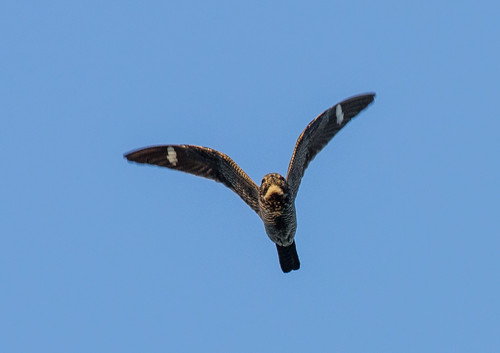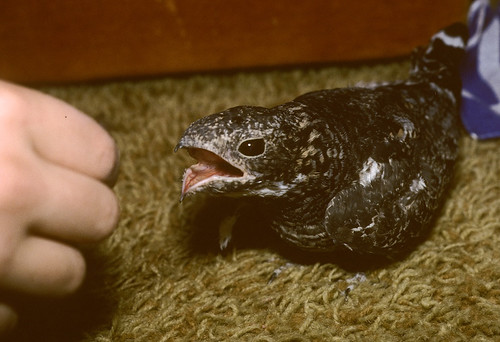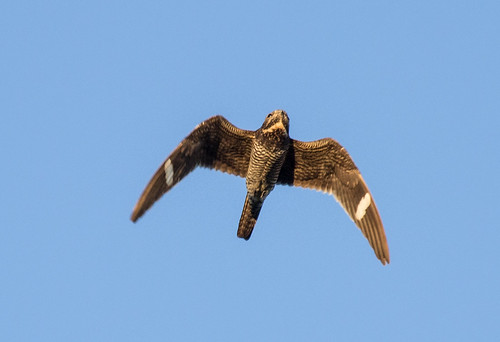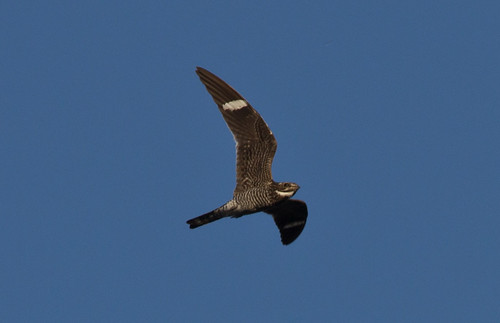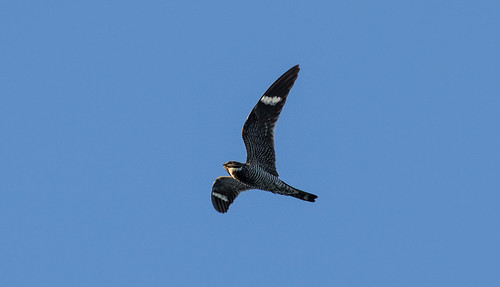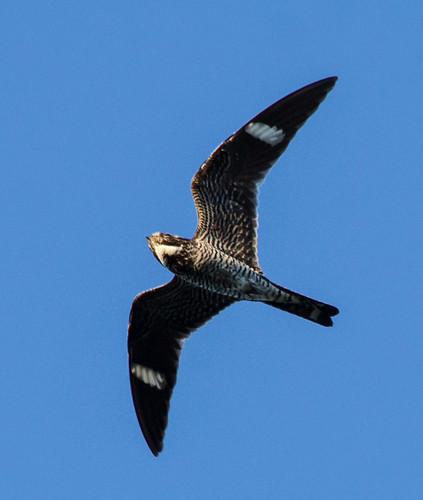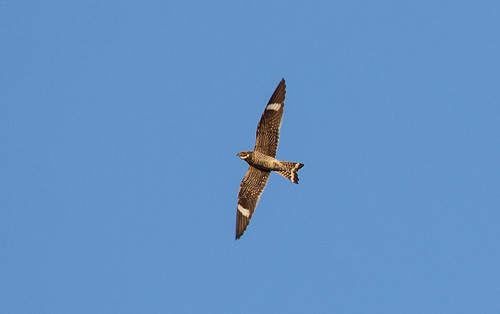For the past three years, the American Birding Association has named a familiar, reasonably common yet declining species as the official ABA Bird of the Year. Two years ago they chose the American Kestrel, last year the Evening Grosbeak, and this year the Common Nighthawk.
Nighthawks have long been among my own very favorite birds. When I was a wildlife rehabber, I specialized on caring for them, and was licensed to keep one individual, named Fred after Mr. Rogers, as an education bird. Having so many nighthawks under my care over the years gave me a rich sense of just how gentle and sweet-natured they are.
Nighthawks are obligate predators, able to eat nothing at all except insects they catch on the wing. They don’t build a nest, but rather make a simple scrape on disturbed ground or gravel-covered flat rooftops. They’re fairly quiet, but in late spring and early summer, we can hear them peenting in the sky at twilight and night. Males make a wondrous flight display, diving toward the ground and suddenly making a booming sound with their wings. The first time I ever saw nighthawks, at Michigan State University in June 1975, I thought the displaying bird was screaming in a panic as he plummeted headlong toward the ground. But he did it over and over, and so first thing the next day I headed to the university library to find out what it was all about. That splendid encounter is seared into my mind’s eye—the kind of lovely memory that almost 40 years later can still warm my soul during dark times.
This past weekend marked Cape May New Jersey’s official nighthawk weekend, because Labor Day Weekend typically marks the peak of migration of this splendid bird through the central states and along the mid-Atlantic Coast. Nighthawk migration along Lake Superior peaks a little earlier than this. Some nighthawks are still passing through, but not in the huge numbers we witnessed two weeks ago. For the past couple of years, Jerry Niemi of the Natural Resources Research Institute in Duluth has been organizing a systematic nighthawk count from the roof of an apartment building on east Superior Street in Duluth. There is no budget to pay people to count throughout daylight hours, but his count at least covers the time from late afternoon until sunset when the birds are seen in largest numbers.
The counter at Hawk Ridge Bird Observatory, Karl Bardon, has exceptionally keen eyes and skills, and an extraordinarily high level of commitment. In addition to his obligation to count raptors, he counts all the other birds winging past the Hawk Ridge main overlook, from hummingbirds and tiny warblers through herons and swans. And during nighthawk migration season, Karl goes above and beyond even that. This year on August 21, when nighthawks were cruising through, he raced down to Jerry’s rooftop counting site to keep his nighthawk tally going for hours after his Hawk Ridge counting responsibilities were over for the day. He ended up counting nighthawks literally from sunrise until sunset, tallying 30,874 nighthawks in that single day.
Nighthawks are reluctant to cross large bodies of water, so their migration is concentrated along the Lake Superior shoreline. So every fall Duluthians can count on at least a few good flights, but in August, nighthawks can sprout up anywhere. As nighthawks finish raising young and start joining flocks, their normal pattern on days with low winds is to mill about starting in mid-afternoon, feeding heavily on flying insects. As individual birds grow satiated, they start flying higher and higher. By nightfall, they’ll be covering a lot of ground in a directed flight. Last week I received a letter from KAXE listener Paul Schanhaar who lucked into witnessing this exact situation a few miles east of Deer River on August 26. Paul writes:
I was outside splitting wood when I noticed shadows moving about on the ground. When I looked up I was surprised to see dozens of very sleek and agile looking birds flying around like you might see swallows doing when feeding on insects just before dark but this was in the middle of the afternoon. Some were as low as only a couple yards overhead [and some were] so high that the wing bars could not be seen. I had never seen this bird before and as I watched and looked around it became apparent there were …hundreds of these graceful birds circling …as far as I could see in any direction. I watched for several minutes and went about my work while keeping an eye on these birds. It was hard to tell if the same birds kept flying overhead or if they were moving on and being replaced by new comers but the action was consistent for more than an hour. …. When the sun shone through their wings the wing bars became brilliant and neon looking. I don’t recall ever seeing a nighthawk before let alone hundreds of them. It was amazing. … Being an avid outdoors person, it surprises me that I’ve not seen this before.
The nighthawk migration spectacle is a silent one, so unless one happens to look up right where nighthawks are milling, it’s hard to realize it’s even happening. On the 21st, while Karl Bardon was counting over 30,000 nighthawks in Duluth, I stood out on Peabody Street with my neighbor Jeanne Tonkin, watching and photographing nighthawks passing over. A couple of cars went by and drivers stopped and asked us what we were looking at. The spectacle seemed so conspicuous that I was taken aback to realize that people right in the midst of it weren’t seeing it, but that’s the nature of nighthawk migration.
Nighthawks face a lot of challenges. Changes in rooftop construction make many rooftops too hot, too slippery, and not camouflaged enough compared to the rock ballasted roofs nighthawks have used for centuries. Burgeoning populations of crows and gulls, which feed on eggs and chicks, are another problem. Mayflies, a major source of food fueling spring migration and the feeding of nighthawk chicks, can still be locally abundant, but there’s strong evidence that mayfly numbers are a fraction of what they once were. Thrilling as this year’s migration has been, it’s just a shadow of what it was a few decades ago.
Until Karl Bardon started counting at Hawk Ridge a few years ago and Jerry Niemi started organizing his East Superior Street counts, we’ve never had systematic counts of nighthawks in Duluth or anywhere else along Lake Superior. The largest flight ever recorded was 43,690 nighthawks counted by Mike Hendrickson on August 26, 1990, from the Lakewood Pumping Station in Duluth. That enormous number was tallied in less than three hours—from 5:35 to 8:20 pm. No one will ever know how many hundreds or thousands more had passed through earlier that day, nor how many were flying on other days that year or in other years. On that day, Mike headed to the pumping station after seeing how many birds were flying over—those birds that attracted his attention in the first place went untallied. During the 80s and early 90s, my family and I watched major nighthawk flights during several evenings every August. Numbers of birds in large flights and numbers of large flights each year have diminished since then. But this year’s wonderful flight provides a glimmer of hope that these lovely birds will long continue winging their way through the late summer sky.
